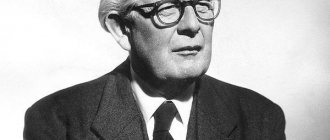Depressio.ru » Glossary of terms
Neuropsychological examination of children is a psychological, non-hardware research method. The diagnostic process is based on technologies proposed by domestic scientist - neuropsychologist A. R. Luria; they include a set of tasks and exercises developed specifically for children, in the form of unique tests. Such an examination is intended to reveal a complete picture of the child’s mental and psychological development, his individual characteristics and potential capabilities. The diagnosis is carried out by a pediatric neuropsychologist.
- Learn more about the functions of this specialist
- At what age is consultation needed?
- Reasons for contacting a specialist
- Read more about consultation and developmental classes
Pathologies studied by science
Let us examine the main pathologies that fall within the scope of neuropsychology.
Disorders are particularly common in the sensory and motor areas . It is known that the formation of an individual, both intellectually and mentally, is directly influenced by brain structures called subcortical.
If a child has a pathology of subcortical formations, he will very quickly feel tired during any activity.
In addition, it will be difficult for him to maintain attention and concentrate on anything, he will constantly be distracted.
There may also be problems remembering any information. Quite often there is a violation of muscle tone (it is too high or, conversely, greatly reduced).
Pediatric neuropsychology conducts research and correctional activities for disorders such as:
- problems with understanding, assimilation and subsequent reproduction of information;
- lag in mastering the school curriculum material;
- obvious difficulties in mastering writing, reading and counting;
- increased activity or, conversely, lethargy;
- increased anxiety and nervousness;
- instability in emotions, sudden mood swings;
- tics and stuttering;
- too low or high muscle tone;
- poor or insufficient motor development;
- poor coordination of movements, the child constantly stumbles and falls.
Respiratory
Promote increased oxygen supply to all organs and tissues, optimize muscle tone, reduce excitability, and improve the general condition of the child.
Breathing is a process that is constantly necessary for a person; during breathing, the brain is abundantly saturated with oxygen; often a child, while performing a difficult task, stops breathing for some time, depriving his body (including the brain) of oxygen. In addition, the breathing function is connected to other brain functions and can cause them to malfunction if there is a disruption in breathing.
Breathing exercises calm you down and help you concentrate. By teaching children to control their breathing and consciously regulate it, they can thereby enable the functions of voluntary self-regulation. The transfer of breathing from an involuntary to a voluntary function is solved by including it as one of the elements in a series of motor exercises.
Neuropsychological syndromes
Neuropsychological syndrome is a stable combination of several disorders of higher mental functions that arise from local lesions of brain structures.
Let's look at the main ones.
Dysgenetic
It includes disorders in the subcortical and stem formations, based on this they distinguish:
- Stem disorders. As a rule, various problems are observed in the functioning of the body’s endocrine system and decreased immunity. Children are diagnosed with diathesis, enuresis and encopresis. Quite often there are problems with sleep. From birth, the baby experiences disharmonious development: motor skills disorders, difficulties with learning speech.
- Subcortical disorders. In this case, intellectual development is somewhat better. Children with this pathology speak very well and do not have difficulty with complex words. But they have headaches quite often. The child has clumsy movements, often trips, hits something, and drops objects.
Such kids quickly get tired of any type of activity and have low performance.It is difficult for them to concentrate on one action or object; their attention constantly jumps. They are absent-minded and forgetful. Often these children also have very illegible handwriting.
Violations of the functionality of the temporal regions
This syndrome is characterized by damage to auditory-verbal memory , when, when repeating named words, the child replaces some words with others and disrupts their order.
The baby also experiences difficulties with sounds that are similar to each other: he often confuses them, and when writing he can often confuse vowels.
Insufficiency of the occipital regions
With such a disorder, the child usually cannot distinguish between spatial factors and exhibits specularity .
There are problems with orientation in space; the baby can hardly show where the right is and where the left is and often confuses the sides.
When writing, it is difficult for him to maintain a line , the words jump, or the line itself tilts in one direction.
Frontal deficiencies
It is characterized by the fact that everything is simplified: writing, reading, speaking .
It is difficult for a child to remember even the simplest rules.
He may not complete words or miss prepositions when writing.
The vocabulary is very small , speech is inexpressive. The construction of phrases itself is simple, for example, “I’m playing,” “I want to go for a walk,” “I ate,” that is, when the baby, expressing his thoughts, uses only monosyllabic sentences.
Oculomotor
By the age of three, a child should already be able to evaluate space at 180 degrees. vertically and 180 deg. horizontally and track it without turning your head. If the scope of visual perception is narrowed, the child sees only what is in front of him. The rest is just by turning the head and the whole body. And it is not surprising that this child can be quite traumatic and gets tired very quickly.
The child’s fragmentation will not only be in the visual sphere, but, as a rule, it will also manifest itself in other spheres, for example, in speech. And just as a child sees fragmentarily, he will hear fragmentarily. For example, the teacher says: “Apple trees grow behind a high fence.” A child can only grasp one fragment, for example: “apple trees are growing,” but he doesn’t know what was before him and what was after him, and he begins to complete anything and fantasize, coming up with something that the teacher did not say at all.
Oculomotor exercises help expand the scope of visual perception and indirectly affect other mental functions (speech, attention, memory).
Oculomotor exercises help eliminate inappropriate cooperative movements. For example, when a child looks at something, his tongue turns on at best, but, as a rule, his whole body turns on. When a child writes, reads, speaks, his leg swings, his tongue spins, he constantly twirls something in his other hand, etc.
Pediatric neuropsychologist - who is he and what does he treat?
A pediatric neuropsychologist carries out activities aimed at the behavior and mental processes of the child, and based on knowledge about the patterns of development and peculiarities of the functioning of the nervous system in childhood.
He works with children aged 3 to 12 years (at this age, brain function is best adjusted) who have the following disorders:
- problems with mastering the school curriculum and completing school assignments (sloppy handwriting, frequent mistakes, falling behind peers);
- instability of the emotional state (sharp mood swings, touchiness, vulnerability);
- reluctance to learn, engage (no motivation to learn);
- delay in speech development or any speech disorders;
- untidiness, lack of independence;
- awkwardness and uncertainty in movements;
- slowness and fatigue;
- restlessness, too much physical activity;
- Difficulty concentrating, easily distractible, inability to focus on anything.
The task of a pediatric neuropsychologist is to carry out a full diagnosis (using specially designed exercises and tests), identify disorders and deviations, develop treatment and corrective activities.
Learn more about the functions of this specialist
Many parents, having heard the recommendation to show their child to a pediatric neuropsychologist, are perplexed, not knowing what he treats, what this doctor does, and for what purposes children are taken to him for consultations. To understand these issues, you need to study in more detail the specifics of the work of a pediatric neuropsychologist.
The human brain, especially a child’s, is a plastic structure that has enormous potential for compensating for various problems and development. The main function of a child neuropsychologist is considered to be the ability to understand and figure out what the child’s true problems are at school, in behavior, in relationships with parents and peers, and then to offer the best methods of work and exercises to compensate for the gaps.
Of course, pediatric neuropsychologists cannot be magicians, and they cannot help children with absolutely any level of impairment (when deeper problems are identified, speech pathologists, psychotherapists and others work with the child, depending on the pathology).
The majority of children who visited specialists in neuropsychology show high performance - they gain the opportunity to study in a regular comprehensive school and avoid ending up in a correctional class. According to reviews from their parents, problems with the child’s perseverance and communication are resolved, and the effectiveness of classes with a speech therapist becomes higher.
At what age is it better to bring a child to a specialist?
You can take your child to a pediatric neuropsychologist if he is already 3 years old. But the most productive age for neuropsychological studies is considered to be the period from 5 to 12 years.
This is explained by the fact that in this period the brain is already formed enough for the child to master and develop skills and abilities.
At the same time, it still has high plasticity so that it can be rebuilt without much difficulty in a fairly short period of time.
What does neuropsychology do?
This section of medicine and psychology studies the relationship between the functioning of the brain and behavior, the human psyche. In other words, a neuropsychologist is a doctor who can objectively assess the state of higher mental functions and help restore them (if they are lost due to severe injury or illness) or develop them when necessary.
The characteristics of brain development are individual for each person. Of great importance is how pregnancy and childbirth, early childhood proceeded, whether severe infections or injuries were suffered, whether developmental activities were appropriate for the child’s age, etc. A neuropsychologist identifies the strengths and weaknesses of the brain in order to bring them to the same level and do the work both hemispheres are more harmonious and productive.
Since a pediatrician evaluates the development and behavior of a child from the point of view of the laws of brain development, higher mental functions and personality and uses specific diagnostic methods, he can identify serious diseases at an early stage and develop the most effective correction program or formative education, taking into account individual characteristics baby.
How is diagnosis carried out?
Neuropsychological diagnostics are carried out in a bright, spacious office, where there are no strangers or distractions and the specialist is left alone with the child.
At the same time, the environment should be calm and friendly : the child should feel comfortable.
The neuropsychologist communicates with the child in short phrases and in simple language. This is necessary so that the baby better understands what is wanted from him.
Diagnostics are carried out in a playful way, in the form of tests and exercises. Its duration is:
- no more than 30 minutes for preschool children;
- 40-50 minutes for students in primary school;
- 1-1.5 hours for children 10-12 years old.
Neuropsychological diagnostics includes studies :
- motor functions;
- writing, counting and reading;
- the ability to recognize objects using the senses;
- level of intellectual development;
- memory;
- speech functions;
- interhemispheric asymmetry (right-handedness and left-handedness).
Difficulties a child faces and ways to overcome them
Every parent wants and believes that their child is the best, smartest and will be successful. Therefore, as soon as a child begins to have problems understanding educational material on the way to mastering the very first academic knowledge at school or even a preschool educational institution, fathers and mothers begin to seriously worry about this. The complexity of the situation is that the reasons why a child begins to lag behind in his studies have different reasons. On the one hand, this may be caused by external objective factors, which lie in the education system as such, with its norms, principles and methods of presenting material.
In this case, if the child cannot quickly fit into this educational paradigm, the parents are powerless and all that remains is to wait for the child to adapt to the educational environment in which he will be for a fairly large period of his life.
On the other hand, there are subjective factors that cause a child to have difficulties while studying - his individual, psycho-emotional and physiological characteristics. In this case, adjustment is quite possible. If a child is not doing well in school due to, for example, increased excitability, then with the help of the selection of correctional techniques, which is what neuropsychology deals with, the situation can be corrected.
An important point is that the use of neuropsychological programs and techniques is indicated not only for children who are lagging behind in their studies, but also for their peers who, on the contrary, show excellent educational results. Neuropsychology should ideally accompany any educational process, and not only in children, but also in adults. Neuropsychological adjustment programs are a state priority, since they solve key problematic issues of psychological difficulties that arise in children during education.
At this point in time, parents and teachers are increasingly faced with children’s failure at school and classify this under one general term – “difficult child.” What’s interesting is that, on the one hand, the child actually experiences difficulties in communicating with peers and teachers, has difficulty remembering material, and on the other hand, there is not a word about pathology in his official medical documents. According to his medical record, the child is absolutely healthy. And all because methods for diagnosing the general physical and psychological health of children are often quite general and superficial. And this is one side of the coin.
On the other hand, the child has a whole range of psychosomatic diseases, which are diagnosed by speech therapists, psychologists and psychotherapists. Such diseases include: various hyperactive syndromes, varying degrees of brain dysfunction, and the like. And over the years, these diagnosed syndromes are only becoming more numerous.
Today, diseases such as “hyper excitability”, “neurotic manifestations”, “autism” and many others are no longer the concern of only specialized specialists. Now everyone knows about these pathologies of the development of the child’s brain, and the number of recorded similar diagnoses is many times higher than 10 years ago.
Parents and teachers should identify such deviations as early as possible in order to influence the situation and correct it. After all, the beginnings of psychosomatic pathologies of the fetus begin to appear during pregnancy in women. By the age of two, it is already possible to trace the presence of certain pathologies in a child.
Today we can talk about risk factors for children that can adversely affect the development of the brain:
- Problems in the prenatal period, genetic predispositions of parents that are harmful in nature, bruises, trauma to the skull, dislocations of limbs, leading to a decrease in the overall motor activity of the baby, cesarean section and early birth;
- Difficulty sleeping, low activity level of the child, the baby does not reach for the mother’s breast, the child is either very active or, on the contrary, very inhibited;
- In the first year of life, the baby suffered a large number of respiratory diseases; he often has gastrointestinal disorders;
- The child is inattentive and very absent-minded, almost never responds to requests from adults to do anything, experiences great difficulty in explaining certain elementary events, and behaves very withdrawn with strangers;
- The baby always gives a negative reaction “no” to any situation or request.
The baby's parents are familiar with such concepts as dysbiosis, enuresis, pancreatitis, hypertension syndrome and others. Moreover, it is absolutely not necessary that any of the listed pathologies are in the child’s medical record. But the very fact that the mother knows about such deviations already indicates problems with the child’s health.
If none of the above factors have ever been recorded by you in your child’s behavior, that’s good. Then you can fully apply neuropsychological techniques to develop your baby’s mental potential. In addition, similar techniques are also useful for adults, because brain training is necessary no less, and maybe even more, than muscle training. The best option is when parents and children study neuropsychology techniques together.
From a very early age, an attentive parent will definitely pay attention to the fact that his baby begins to speak or walk later in comparison with his peers, when he is inhibited in actions, when he cannot hold a spoon, but by age he should, when he has difficulties with mastering basic physical exercises. And the older the child gets, the more these developmental “problems” make themselves felt. The development of intelligence is especially affected by inhibition in speech skills. And this, in turn, seriously complicates the child’s socialization and his learning potential.
Problems that arise in a child at a fairly early age, without proper correction, then degenerate into more serious difficulties and deviations in junior and senior school age. When a child stays at home with his mother, many gaps in his development may not be so noticeable. But as soon as he crosses the threshold of kindergarten, developmental difficulties come to the surface. At school the situation gets even worse. It is more difficult for children to perceive educational material, they become aggressive with peers and teachers, and this process can only become more complicated.
Many parents have noticed how their children do not distinguish between right and left sides, write letters backwards and other things. As a rule, rarely does anyone attach serious importance to these “little things.” But in vain. When a child goes to first grade, these “little things” begin to become a serious obstacle to acquiring knowledge. But the foundations of space and time are laid in the child’s brain in the first months of life.
Spatial and temporal ideas about the world around us develop in a child’s brain in a kind of progression: from smaller to larger volumes.
There are several levels of development of spatio-temporal orientation, presented in the works of Semenovich:
First level: dark muscle sense - human proprioceptive system based on the biological clock;
Second level: somatognosis or body diagram - a model according to which all sensitive mechanisms of the human body are formed;
Third level: metrics and topology - the first steps towards interconnection with the outside world, a sense of oneself in a certain time and space;
Fourth level: coordinate representations - top-bottom, past-present-future;
Fifth level: structural-topological representations - perception and representation of the surrounding world, not only objects, but also events, as well as one’s involvement in them;
Sixth level: projection representations - designations of complex format structures, inclusion of abstract images in the understanding of surrounding relationships and attitude to the category of time as a conceptual component of life processes;
Seventh level: strategy, the cognitive aspect of the individual - a holistic perception of oneself and the world around.
Thus, all of the levels listed above demonstrate the interconnection with each other and the next stage of development is possible only after passing the previous level.
The cognitive characteristics of a child, his mental maturation, begin with knowledge of the world at the physical level. In order for a child to navigate where the right or left side is, for example, he must begin to crawl and turn in different directions during infancy. The closeness and tactility of the mother is of paramount importance in this sense. The child must first feel this world with his body, and only then the body will give a signal to the mind.
Therefore, before assessing why a child is learning weaker than others in the class, you need to “rewind the film” back and remember how his development went in the first months of life. The reason for failure is hidden there.
As a result, we can conclude the following: problems in human development, regardless of the type of psychological difficulties, arise for three main reasons:
- The person has not mastered the mechanisms of voluntary self-regulation. It is difficult for him to concentrate on a specific goal and fails to bring the work he has started to its logical conclusion, as well as other manifestations of low will;
- The person experiences an acute lack of neurosomatic balance. This is manifested in increased muscle tone, rapid fatigue, a tendency to depressive moods and imbalance in assessments and reactions, weather dependence and more;
- A person has poor intellectual and speech potential, his cognitive mechanisms are at a low level.
The problems of cognitive activity among children are illustrated very well in the process of analyzing their writing. Researcher A.R. Luria paid special attention to writing in his scientific works. In his opinion, in order to write a word correctly, the brain needs to perform a sufficient number of recognition operations, including phonemic analysis of the word form. Then, the sound isolated from the general flow must be transformed into a graphic sign. And this is all connected with the last stage, when the recognized letter sign still needs to be written down using motor activity. This process, in fact, quite often becomes a real problem for children.
It is advisable to detect such difficulties in children as early as possible, and it is much more productive to correct the same letter for a preschooler than to work on hand positioning and correct earlier mistakes later at school.
It is very important for a child to have an established neurosomatic basis for behavior as early as possible.
Children may encounter a variety of complications in the implementation of this or that activity, and this cannot always be quickly and correctly diagnosed, and therefore it is necessary to engage in a neurosomatic program in advance. The program will help children who are lagging behind in their studies, and will give high-achieving children a new powerful incentive.
Neuropsychology offers a number of effective techniques that will help a child build cognitive activity in a favorable way.
Doctor visit time
The most appropriate age for the first visit to a pediatric neuropsychologist is 5-6 years, during preparation for school. This time is most suitable for diagnosing and identifying problems that a child may have at school. In addition, this age allows, if necessary, to carry out correction without overloading the baby. A second visit to the doctor is recommended at 8-9 years of age. This is especially important for parents who did not visit a specialist in preschool age and notice some problems in their child. Restlessness, poor grades, and behavior problems are clear signs of dysfunction. You can help solve this kind of problem in both cases, but it is advisable to see a specialist in a timely manner. This will make it possible to achieve results faster, without stress for the child.
Problems that a neuropsychologist can help you get rid of
The reasons for visiting a doctor are individual for each person, as is the environment in which they develop.
With the help of a professional doctor of neuropsychology in Shchelkovo, you can cope with the following developmental problems:
- Problems with speech development.
- Lack of motivation for education.
- Increased vulnerability and susceptibility.
- Uncertainty in your movements and gait.
- Lack of perseverance – hyperactivity.
- Excessive infantilism of children in simple situations.
- Difficulty understanding and repeating training material.
Children's in the city of Shchelkovo provides therapy exclusively with the help of techniques and exercises in an active play form. Our pediatric neuropsychologists in Shchelkovo have higher education and extensive experience in this activity. By sending your kids to us, you can be calm about the development of your baby. The children's room is located at: Shchelkovo, st. Talsinskaya 24 A










